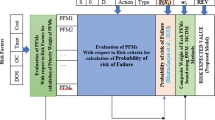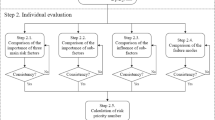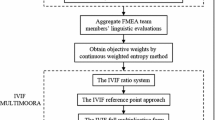Abstract
Failure modes and effects analysis (FMEA) has been used to identify the critical risk events and predict a system failure to avoid or reduce the potential failure modes and their effect on operations. The risk priority number (RPN) is the classical method to evaluate the risk of failure in conventional FMEA. RPN, which ranges from 1 to 1000, is a mathematical product of three parameters—severity (\(S\)), occurrence (\(O\)), and detection (\(D\))—to rank and assess the risk of potential failure modes. However, there are some shortcomings of the conventional RPN method, such as: the RPN elements have many duplicate numbers; violate the assumption of measurement scales; and have not considered the weight of \(S, O\), and \(D\). In order to improve the aforementioned shortcomings of the conventional RPN calculation problem, this paper presents an easy yet effective method to enhance the risk evaluation capability of FMEA. The new method is named exponential risk priority number (ERPN), which uses a simple addition function to the exponential form of \(S, O\), and \(D\) to substitute the conventional RPN method, which is a mathematical product of three parameters. Two practical cases are used to demonstrate that the ERPN method can not only resolve some problems of the conventional RPN method but also is able to provide a more accurate and reasonable risk assessment in FMEA.





Similar content being viewed by others
References
Automotive Industry Action Group (AIAG). (2008). Potential failure mode and effect analysis (FMEA) reference manual. FMEA reference manual (4th ed).
Ben-Daya, M., & Raouf, A. (1996). A revised failure mode and effects analysis model. International Journal of Quality and Reliability Management, 13(1), 43–47.
Bowles, J. B. (1998). The new SAE FMECA standard. In Processing annual reliability and maintainability, symposium, pp. 48–53.
Bowles, J. B. (2003). An assessment of RPN prioritization in a failure modes effects and criticality analysis. In Processing annual reliability and maintainability, symposium, pp. 380–386.
Bowles, J. B., & Pelaez, C. E. (1995). Fuzzy logic prioritization of failures in a system failure modes, effects and criticality analysis. Reliability Engineering and System Safety, 50(2), 203–213.
Braglia, M., Frosolini, M., & Montanari, R. (2003). Fuzzy TOPSIS approach for failure mode, effects and criticality analysis. Quality and Reliability Engineering International, 19(5), 425–443.
Chang, C. L., Wei, C. C., & Lee, Y. H. (1999). Failure mode and effects analysis using fuzzy method and grey theory. Kybernetes, 28(3–7), 1072–1080.
Chang, D. S., & Sun, K. L. P. (2009). Applying DEA to enhance assessment capability of FMEA. International Journal of Quality and Reliability Management, 26(6), 629–643.
Chang, K. H. (2009). Evaluate the orderings of risk for failure problems using a more general RPN methodology. Microelectronics Reliability, 49(12), 1586–1596.
Chang, K. H., & Cheng, C. H. (2009). A novel general approach to evaluating the PCBA reliability for components with different membership function. Applied Soft Computing, 9(3), 1044–1056.
Chang, K. H., & Cheng, C. H. (2010). A risk assessment methodology using intuitionistic fuzzy set in FMEA. International Journal of Systems Science, 41(12), 1457–1471.
Chang, K. H., & Cheng, C. H. (2011). Evaluating the risk of failure using the fuzzy OWA and DEMATEL method. Journal of Intelligent Manufacturing, 22(2), 113–129.
Chang, K. H., Cheng, C. H., & Chang, Y. C. (2010). Reprioritization of failures in a silane supply system using an intuitionistic fuzzy set ranking technique. Soft Computing, 14(3), 285–298.
Chien, C. F., & Zheng, J. N. (2012). Mini-max regret strategy for robust capacity expansion decisions in semiconductor manufacturing. Journal of Intelligent Manufacturing, 23(6), 2151–2159.
Chin, K. S., Wang, Y. M., Poon, G. K. K., & Yang, J. B. (2009). Failure mode and effects analysis by data envelopment analysis. Decision Support Systems, 48(1), 246–256.
Ford Motor Company. (1988). Potential failure mode and effects analysis. Instruction manual.
Gabus, A., & Fontela, E. (1973). Perception of the world problematique: Communication procedure, communicating with those bearing collective responsibility (DEMATEL report no.1). Geneva, Switzerland: Battelle Geneva Research Centre.
Gilchrist, W. (1993). Modelling failure modes and effects analysis. International Journal of Quality and Reliability Management, 10(5), 16–23.
Hsiao, T. Y., & Lu, C. N. (2008). Risk informed design refinement of a power system protection scheme. IEEE Transactions on Reliability, 57(2), 311–321.
Hussain, O. K., Dillon, T., Hussain, F. K., & Chang, E. (2012). Probabilistic assessment of loss in revenue generation in demand-driven production. Journal of Intelligent Manufacturing, 23(6), 2069–2084.
International Electrotechnical Commission, Geneva. (1985). Analysis techniques for system reliability-procedures for failure mode and effect, analysis. IEC812.
Karlsson, B., Karlsson, N., & Wide, P. (2000). A dynamic safety system based on sensor fusion. Journal of Intelligent Manufacturing, 11(5), 475–483.
Kubat, C., & Yuce, B. (2012). A hybrid intelligent approach for supply chain management system. Journal of Intelligent Manufacturing, 23(4), 1237–1244.
Pillay, A., & Wang, J. (2003). Modified failure mode and effects analysis using approximate reasoning. Reliability Engineering and System Safety, 79(1), 69–85.
Sankar, N. R., & Prabhu, B. S. (2001). Modified approach for prioritization of failures in a system failure mode and effects analysis. International Journal of Quality and Reliability Management, 18(3), 324–335.
Seyed-Hosseini, S. M., Safaei, N., & Asgharpour, M. J. (2006). Reprioritization of failures in a system failure mode and effects analysis by decision making trial and evaluation laboratory technique. Reliability Engineering and System Safety, 91(8), 872–881.
Sharma, R. K., Kumar, D., & Kumar, P. (2005). Systematic failure mode effect analysis (FMEA) using fuzzy linguistic modeling. International Journal of Quality and Reliability Management, 22(9), 986–1004.
Tay, K. M., & Lim, C. P. (2006). Application of fuzzy inference techniques to FMEA. Applied Soft Computing Technologies: The Challenge of Complexity, 34, 161–171.
US Department of Defense Washington, DC (1974). Procedures for performing a failure mode effects and criticality analysis. US MIL-STD-1629.
US Department of Defense Washington, DC (1980). Procedures for performing a failure mode effects and criticality analysis. US MIL-STD-1629A.
Wang, J., Ruxton, T., & Labrie, C. R. (1995). Design for safety of engineering systems with multiple failure state variables. Reliability Engineering and System Safety, 50(3), 271–284.
Wang, Y. M., Chin, K. S., Poon, G. K. K., & Yang, J. B. (2009). Risk evaluation in failure mode and effects analysis using fuzzy weighted geometric mean. Expert Systems with Applications, 36, 1195–1207.
Xu, K., Tang, L. C., Xie, M., Ho, S. L., & Zhu, M. L. (2002). Fuzzy assessment of FMEA for engine system. Reliability Engineering and System Safety, 75(1), 17–29.
Yeh, R. H., & Hsieh, M. H. (2007). Fuzzy assessment of FMEA for a sewage plant. Journal of the Chinese Institute of Industrial Engineers, 24(6), 505–512.
Zhang, D. Y., Cao, X., Wang, L., & Zeng, Y. (2012). Mitigating the risk of information leakage in a two-level supply chain through optimal supplier selection. Journal of Intelligent Manufacturing, 23(4), 1351–1364.
Zhu, J. (2003). Quantitative models for performance evaluation and benchmarking: data envelopment analysis with spreadsheets and DEA Excel Solver. Boston: Kluwer.
Acknowledgments
The author would like to express his sincerest gratitude to the anonymous referees for providing very helpful comments and suggestions which led to an improvement of the article. This work was supported in part by the National Science Council of the Republic of China under Contract No. NSC 99-2410-H-145-001 and NSC 101-2410-H-145-001.
Author information
Authors and Affiliations
Corresponding author
Rights and permissions
About this article
Cite this article
Chang, KH., Chang, YC. & Lai, PT. Applying the concept of exponential approach to enhance the assessment capability of FMEA. J Intell Manuf 25, 1413–1427 (2014). https://doi.org/10.1007/s10845-013-0747-9
Received:
Accepted:
Published:
Issue Date:
DOI: https://doi.org/10.1007/s10845-013-0747-9




